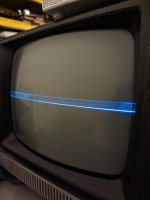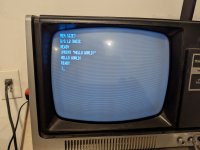I bought a TRS-80 Model I (Level II) and monitor at the VCF East event this weekend. Awaiting purchased power supply to test/troubleshoot the computer, but the monitor definitely doesn't work. The 1A fuse in the power supply was blown; replaced it and blew again immediately so troubleshooting the circuit board using the Sam's guide found here: https://www.heinpragt.com/retro_com...rFacts - Model I (1985)(Howard Sams)(pdf).pdf
I went through the troubleshooting guide, which mentioned only diode CR101 and capacitor C110 as potential causes for blown fuse. Diode check on CR101 looked good, and capacitor was correct value on capacitor meter and not shorted, so moved on to testing all other capacitors and diodes, and resistance measurements.
My first question is about the resistance measurements on page 60 of the PDF (page 18 of the original CSCS3-B document). It gives a table of pin numbers plotted against diode and other part leads, with expected resistance values. The rows are for transistor and other parts, and columns are "Pin" numbers. I must not be understanding the testing methodology, because I can't figure out what any of those Pin numbers correspond to. The only numbered items I can associate with the columns anywhere in the document are:
- the notations 1-6 on page 48 (pdf)/6 (CSCS3-B) with associated voltage readings (but I don't see anything but no-connect from those voltage points to the transistor leads)
- notations 5,7,11 page 55/13 (this can't be right since then there would be two Pin 5, plus where are 8/9/10?)
- notations 12-58 on page 57/15 (almost none of these are even the low numbers associated with the resistance table, since it starts with 12)
- the pins that connect to the graphics board (but there are only 12 pins in the connection slots, and the resistance table indicates 13/14 pins)
So what are the "Pin" columns? I was expecting you'd hook one ohmmeter lead to whatever Pin location, and the other lead to the indicated lead on the named component, and check the reading, but I am clearly missing something. Or perhaps one of my conflicting guesses was correct, but my multimeter is not feeding enough power to the resistance check to get through semiconductors?
My second question is about diode readings: I get a valid-looking diode check for most of the CRxx parts (0.5-0.7V) as they sit in-circuit, with the exception of two of them:
- CR7 (get .1V diode check either direction, measure constant 155 ohm each direction)
- CR19 (get .1V diode check either direction, measure constant 170 ohm each direction)
Are these values expected because I'm doing in-circuit measurement and other nearby components are rerouting the applied voltage, or are these problematic? I have desoldering equipment but I don't want to start mucking with that until I've done all the tests I can do with the circuit intact.
Thanks for any help.
I went through the troubleshooting guide, which mentioned only diode CR101 and capacitor C110 as potential causes for blown fuse. Diode check on CR101 looked good, and capacitor was correct value on capacitor meter and not shorted, so moved on to testing all other capacitors and diodes, and resistance measurements.
My first question is about the resistance measurements on page 60 of the PDF (page 18 of the original CSCS3-B document). It gives a table of pin numbers plotted against diode and other part leads, with expected resistance values. The rows are for transistor and other parts, and columns are "Pin" numbers. I must not be understanding the testing methodology, because I can't figure out what any of those Pin numbers correspond to. The only numbered items I can associate with the columns anywhere in the document are:
- the notations 1-6 on page 48 (pdf)/6 (CSCS3-B) with associated voltage readings (but I don't see anything but no-connect from those voltage points to the transistor leads)
- notations 5,7,11 page 55/13 (this can't be right since then there would be two Pin 5, plus where are 8/9/10?)
- notations 12-58 on page 57/15 (almost none of these are even the low numbers associated with the resistance table, since it starts with 12)
- the pins that connect to the graphics board (but there are only 12 pins in the connection slots, and the resistance table indicates 13/14 pins)
So what are the "Pin" columns? I was expecting you'd hook one ohmmeter lead to whatever Pin location, and the other lead to the indicated lead on the named component, and check the reading, but I am clearly missing something. Or perhaps one of my conflicting guesses was correct, but my multimeter is not feeding enough power to the resistance check to get through semiconductors?
My second question is about diode readings: I get a valid-looking diode check for most of the CRxx parts (0.5-0.7V) as they sit in-circuit, with the exception of two of them:
- CR7 (get .1V diode check either direction, measure constant 155 ohm each direction)
- CR19 (get .1V diode check either direction, measure constant 170 ohm each direction)
Are these values expected because I'm doing in-circuit measurement and other nearby components are rerouting the applied voltage, or are these problematic? I have desoldering equipment but I don't want to start mucking with that until I've done all the tests I can do with the circuit intact.
Thanks for any help.


